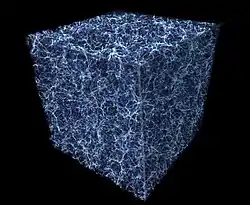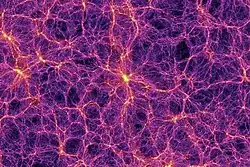Large-scale structure of the Universe
Large-scale structure of the Universe refers to the patterns of galaxies and matter on scales much larger than individual galaxies and groupings of galaxies. These correlated structures can be seen up to billion of light years in length and are created and shaped by gravity.[1] On large scales Universe displays coherent structure, with galaxies residing in groups and clusters on scale of ~1-3 Mpc/h, which lie at the intersections of long filament of galaxies that are> 10 Mpc/h in length. Vast regions of relatively empty space, known as voids, contain very few galaxies and span in the volume in between these structures.[2]


It's amplified to enormous proportion by gravitational forces, producing ever-growning concentrations of dark matter in which ordinary gases cool, condense and fragment to make galaxies.[3]
References
- "Large-Scale Structure". The Dark Energy Survey. Retrieved 2020-11-02.
- Coil, Alison L. (2013). "The Large-Scale Structure of the Universe". Large Scale Structure of the Universe. pp. 387–421. arXiv:1202.6633. Bibcode:2013pss6.book..387C. doi:10.1007/978-94-007-5609-0_8. ISBN 978-94-007-5608-3. S2CID 56104933.
- Springel, Volker; Frenk, Carlos S.; White, Simon D. M. (April 2006). "The large-scale structure of the Universe". Nature. 440 (7088): 1137–1144. arXiv:astro-ph/0604561. Bibcode:2006Natur.440.1137S. doi:10.1038/nature04805. ISSN 1476-4687. PMID 16641985. S2CID 8900982.